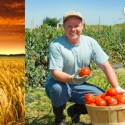C-AGG Guiding Principles
Science-Based | Quantifiable, Verifiable and Results-Based
Innovation | Additionality | Permanence
Comprehensive GHG Accounting | Co-benefits
Bundling Environmental Benefits | Stakeholder Engagement
Science-Based
The design of agricultural climate policy must be informed by the best available science and should be adaptable over time to integrate improved science.
Quantifiable, Verifiable and Results-Based
Only quantifiable and verifiable programs and activities that deliver net reductions of atmospheric GHG concentrations should be rewarded.
- Larger rewards should be provided to participants that deliver greater results to encourage the private sector to reduce atmospheric GHG concentrations at scale and as quickly as possible.
- Tradeoffs between precision and accuracy of quantification and cost will be necessary, but should diminish over time, as innovation delivers better technology and lowers costs.
- Programs and activities should focus on the result desired (e.g. net reductions or removal of GHGs) rather than the means of achieving the result (what practice was implemented). Although systems based on direct measurements are preferred, certain practices have been proven to deliver results (i.e., net reductions in atmospheric GHG concentrations) with a high degree of precision and accuracy, and certain models have proven accurate in estimating reductions for particular practices when calibrated using appropriate data.
- Leakage of emissions outside of the program or activity boundary that occurs as a result of the program or activity should be accounted for where possible.
- Verification of results should occur on a regular basis and be performed by an independent third party.
Innovation
Accelerating innovation is critical to delivering substantial net reductions in atmospheric GHG concentrations. Many innovators are early actors and the results delivered by their actions should be recognized.
Additionality
Only net reductions of atmospheric GHG concentrations beyond business as usual should be rewarded.
Permanence
Programs and activities should provide for continued storage of sequestered carbon over timeframes that are meaningful in the context of mitigating climate change.
- A way to address the issue of permanence is “risk-based” analysis of the likelihood that a reversal of sequestered carbon could occur. Different project activities have different factors that increase or decrease the risk of reversals.
- Policy should distinguish between intentional and unintentional reversals.
Comprehensive GHG Accounting
A comprehensive accounting should be made of all GHG’s impacted by a program or activity.
Co-benefits
Programs and activities should identify social and non-GHG environmental impacts and take steps to mitigate those impacts where possible. Contributions to social and community well-being; conservation of biodiversity; and improvements to soil, air and water quality should be encouraged.
Bundling Environmental Benefits
Activities that generate multiple environmental benefits that can be clearly identified should potentially qualify for multiple credits or incentives.
- Where multiple benefits are positive and additional, efforts to separately quantify, verify and value them should be encouraged.
- Where there are tradeoffs between achieving multiple benefits, the programs and activities should seek to optimize the environmental outcome.
- Multiple benefits should be tracked in a standardized accounting system that provides integrity to the programs and activities by preventing multiple payments for the same environmental benefit.
Stakeholder Engagement
Stakeholders should be engaged in a transparent, accountable consultation process with program administrators. The consultation process should take account of comments and suggestions from stakeholders in the design of technical standards.
The following individuals contributed to the preparation of these principles (affiliations listed for identification only):
David Antonioli, Voluntary Carbon Standard Association
Steve Apfelbaum, Applied Ecological Services, Inc.
Andrew Arnold, SureHarvest
Ricardo Bayon, EKO Asset Management Partners
Jason Clay, World Wildlife Fund
Craig Cox, Environmental Working Group
Steve De Gryze, Terra Global Capital, LLC
Jeff Dlott, SureHarvest
Keith Driver, Blue Source Canada
Leslie Durschinger, Terra Global Capital, LLC
Karen Haugen-Kozyra, Climate Change Central
Eric Holst, Environmental Defense Fund
John Kadyszewski, Winrock International
Alexia Kelly, World Resources Institute
John Kimble, Consultant
Rattan Lal, Carbon Management and Sequestration Center,
OARDC/FAES, The Ohio State University
Timothy LaSalle, The Rodale Institute
Daniella Malin, Sustainable Food Lab
Liz Mathern, North Dakota Farmers Union
Ken Newcombe, C-Quest Capital LLC
Lydia Olander, Nicholas Institute for Environmental Policy Solutions, Duke University
Phil Ovitt, C-Quest Capital LLC
Debbie Reed, DRD Associates
Walt Reid, The David and Lucile Packard Foundation
Charles Rice, Kansas State University
Bill Salas, Applied Geosolutions, Inc.
Gia Schneider, EKO Asset Management Partners
Jerry Seager, Voluntary Carbon Standard Association
Johan Six, University of California-Davis
Charlotte Streck, Climate Focus
Roger Williams, Blue Source
C-AGG Principles have been endorsed by the following organizations:
AgRefresh
Blue Source
Climate Change Central
Delta Institute
EKO Asset Management Partners
Environmental Defense Fund
National Farmers Union
North Dakota Farmers Union
Rodale Institute
The Earth Partners and Applied Ecological Services, Inc.
Voluntary Carbon Standard Association
Winrock International
Guiding Principles

Members of the Coalition on Agricultural Greenhouse Gases propose the following guiding principles for designing policy
to enable the agricultural sector to participate effectively in the effort to mitigate climate change.
Getting Measurable Results

Carbon and Agriculture: Getting Measurable Results is a C-AGG Report providing information useful for designing policies and programs to realize agriculture’s potential contributions to Greenhouse Gas mitigation.
Thank you for your generous support!

The David and Lucile Packard Foundation's goals, through the use of grants, are to improve the lives of children, enable creative pursuit of science, advance reproductive health, and conserve and restore earth’s natural systems.




